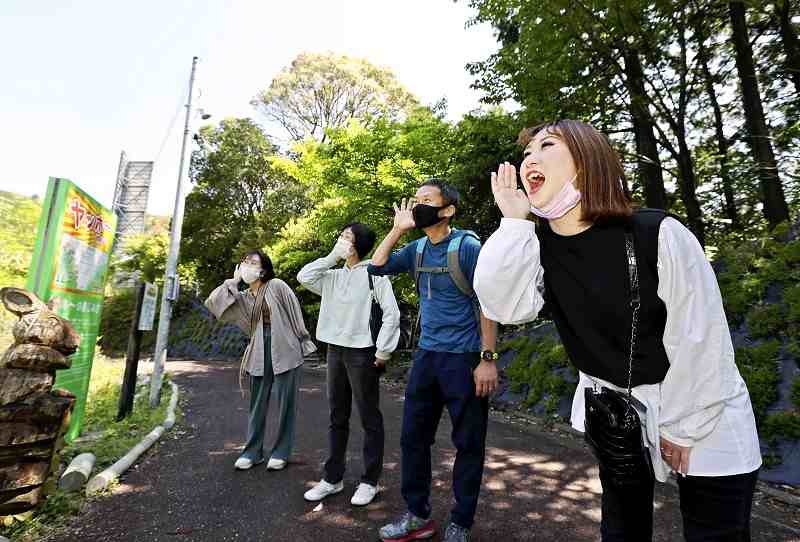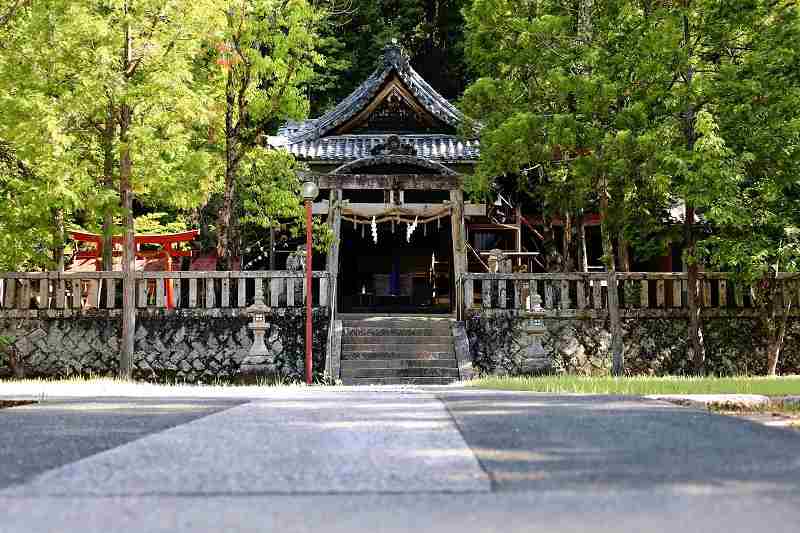
A woman shouts while others try to hear echoes bouncing back from the facing mountain.
8:36 JST, June 26, 2021
HIDAKAGAWA, Wakayama — Many Japanese people want to shout “Ya-ho” when reaching the summit of a mountain to hear their echo, but it’s a task easier said than done.
I’ve heard the best spot for hearing your echo is in the mountains of Hidakagawa, Wakayama Prefecture. It is said to be Japan’s No. 1 echo spot.
I visited there in early May in the hopes of getting rid of accumulated stress as shouting in public is especially frowned upon during the pandemic.
Taking off the mask
The spots are called “Ya-ho points” and are in Green Park Tsubayama. The park is on the shore of Tsubayama Dam Lake surrounded by the Kii mountain range.
As I crossed the suspension bridge on my way to the park from the parking lot, I heard some people shouting out. All three “Ya-ho points” are concentrated around here.

A suspension bridge near the “Ya-ho points”
A 42-year-old man visited the park with his family from Gobo in the prefecture. He looked refreshed.
“I don’t remember the last time I could just take off my mask and shout as much as I wanted,” he said.
An 8-year-old boy from the same city said, “I can’t talk loudly at school, so it was really fun.”
I was able to clearly hear echoes bouncing back from the mountains. I wondered, however, why this spot was considered the best in Japan.
An echo sounds beautiful when you shout for two seconds so that the echo begins just as you stop. The spots are about 300 meters away from a facing mountain — an ideal distance.
The spots were discovered in 2006 by Makoto Kise, 63, a flute maker living in Wakayama, after searching in about 4,000 places around the prefecture over nearly 10 years.
The local Hidakagawa town government put up a signboard in 2010 to promote the spot, which became popular and attracted as many as 500 tourists a day at its peak.
There are far fewer tourists from outside the prefecture due to the pandemic. But Yusaku Ihara, an official of the town’s tourism association, proudly said, “This spot is far from crowded. You can enjoy the exhilarating feeling [of shouting here]. ”
Origins of ‘Ya-ho’
I shouted, too, and it perfectly echoed back from the mountain. It sounds clearer if the ending of the shout is not lengthened, Ihara said. While I was having fun shouting over and over again, a question came to me.
Japanese shout “Ya-ho” when we want to hear our echo, but why?
I asked Hiroshi Hagiwara, special editor-in-chief of Yama-kei Publishers Co., a publishing company dedicated to mountain-related books.
The most probable theory is that the word originated from the German word “Johoo,” a word that climbers use to call out to others. Some Japanese heard this when learning how to ski from an Austrian in the Taisho era (1912-1926) and it gradually turned to “Ya-ho,” said Hagiwara.
And if you shout, for example, “O-i!” (Hey!), it could be misunderstood as a call for help, Hagiwara said.
A mountain monster

Yamabiko is depicted as a yokai monster in “Gazu Hyakki Yagyo.”
I overheard many people singing the popular children’s song “I Met a Bear” at the park, too. As singing echoes so nicely, it is possible to enjoy as if singing in a round alone.
In Japan, an echo was once thought to be the work of a yokai monster.
In “Gazu Hyakki Yagyo,” a collection of paintings from the mid-Edo period in the 18th century, an animal-like creature named Yamabiko is depicted with its arms outstretched on a mountain peak.
Kodama, which similarly means the echoing phenomenon, is depicted as the spirit of a tree or a spirit living in a tree.
“In the past, people probably were scared when they heard voices coming from the mountains that were supposed to be uninhabited, so they attributed the voices to yokai monsters,” said Masanobu Kagawa, a curator at the Hyogo Prefectural Museum of History.
It seems people have been shouting loudly in the mountains since ancient times if a folktale was created to explain echoes in the mountains.
Why, then, do people feel like shouting in the mountains? When asked, Hagiwara laughed and said, “Because the mountains are there, I presume.”
— How to get there
Green Park Tsubayama is 45 minutes by car from the Arida Interchange on the Yuasa-Gobo Road, and about 80 minutes by bus from JR Gobo Station, of which service is not frequent. There are walkways for visitors in the park, allowing them to experience all three “Ya-ho points” in about 20 minutes. Parking is free and public restrooms are available.
— Extend your trip!
Niu Shrine

Niu Shirine
A strange festival is held every October at Niu Shrine in Hidakagawa. The Niu Festival is considered to be a “laughing festival.” It is said the festival started when local villagers cheered up their local deity, who was depressed after running late for a gathering of deities. Shrine parishioners parade in the neighborhood while loudly chanting “Yo wa rakuja, warae, warae” (Life is easy. Laugh, laugh).
Related Tags
"Features" POPULAR ARTICLE
-

Sanrio to Open Museum in Yamanashi Pref. Dedicated to Founder, Exhibits Include Hello Kitty, Other Characters
-

Autumn Foliage Surrounds Visitors to Tokyo’s Showa Kinen Park
-

My Daughter No Longer Speaks to Me, But I Want to See Her and My Grandchild
-

Kumamoto: Public Bath Refurbished as Library Where You Can Chat, Take Photos
-

Frozen Vegetables: Demand Rises for Convenient, Tasty Domestic Produce
JN ACCESS RANKING
-

Keidanren Chairman Yoshinobu Tsutsui Visits Kashiwazaki-Kariwa Nuclear Power Plant; Inspects New Emergency Safety System
-

Tokyo Economic Security Forum to Hold Inaugural Meeting Amid Tense Global Environment
-

Imports of Rare Earths from China Facing Delays, May Be Caused by Deterioration of Japan-China Relations
-

University of Tokyo Professor Discusses Japanese Economic Security in Interview Ahead of Forum
-

Japan Pulls out of Vietnam Nuclear Project, Complicating Hanoi’s Power Plans

























